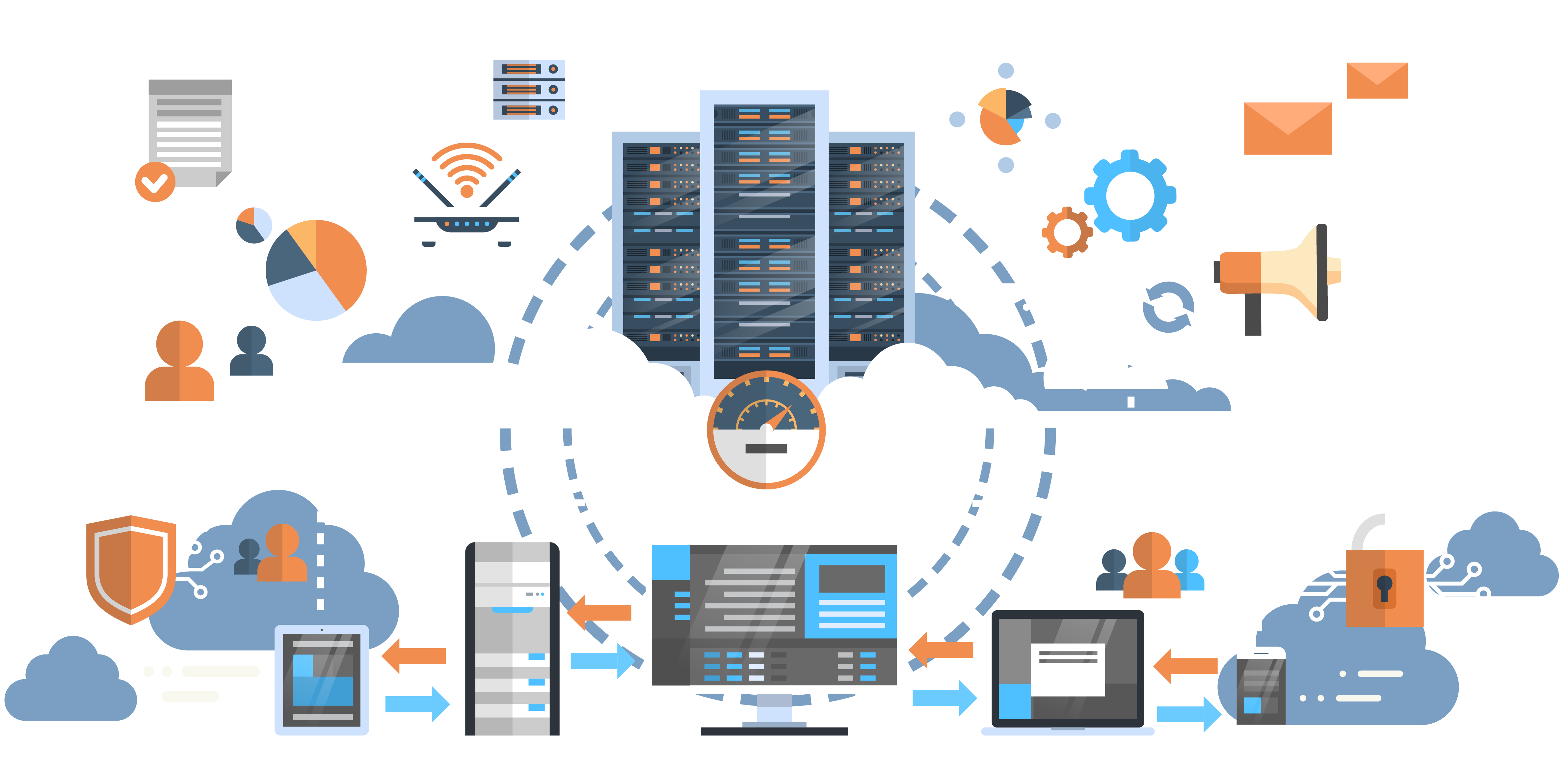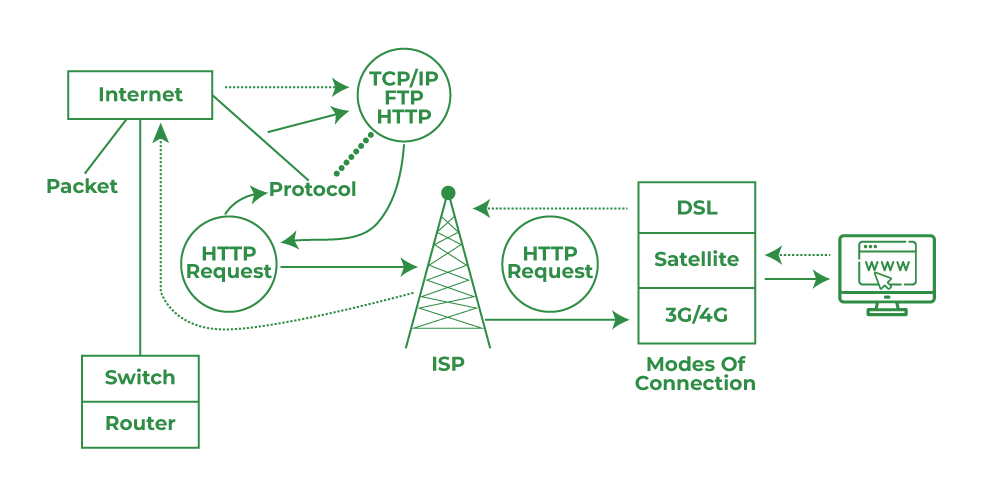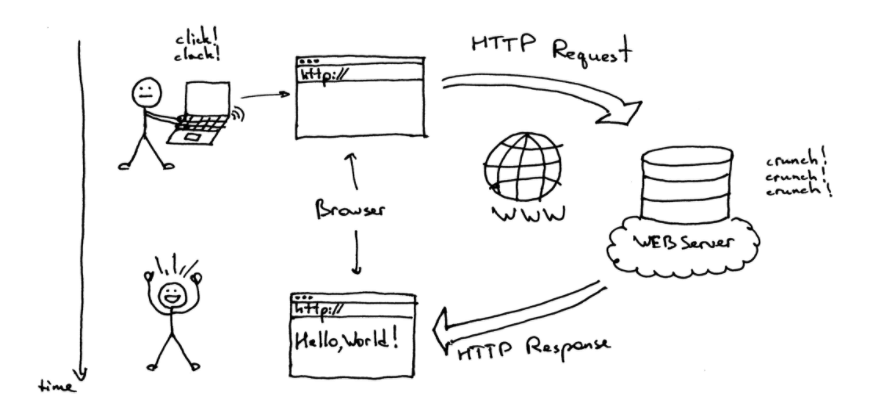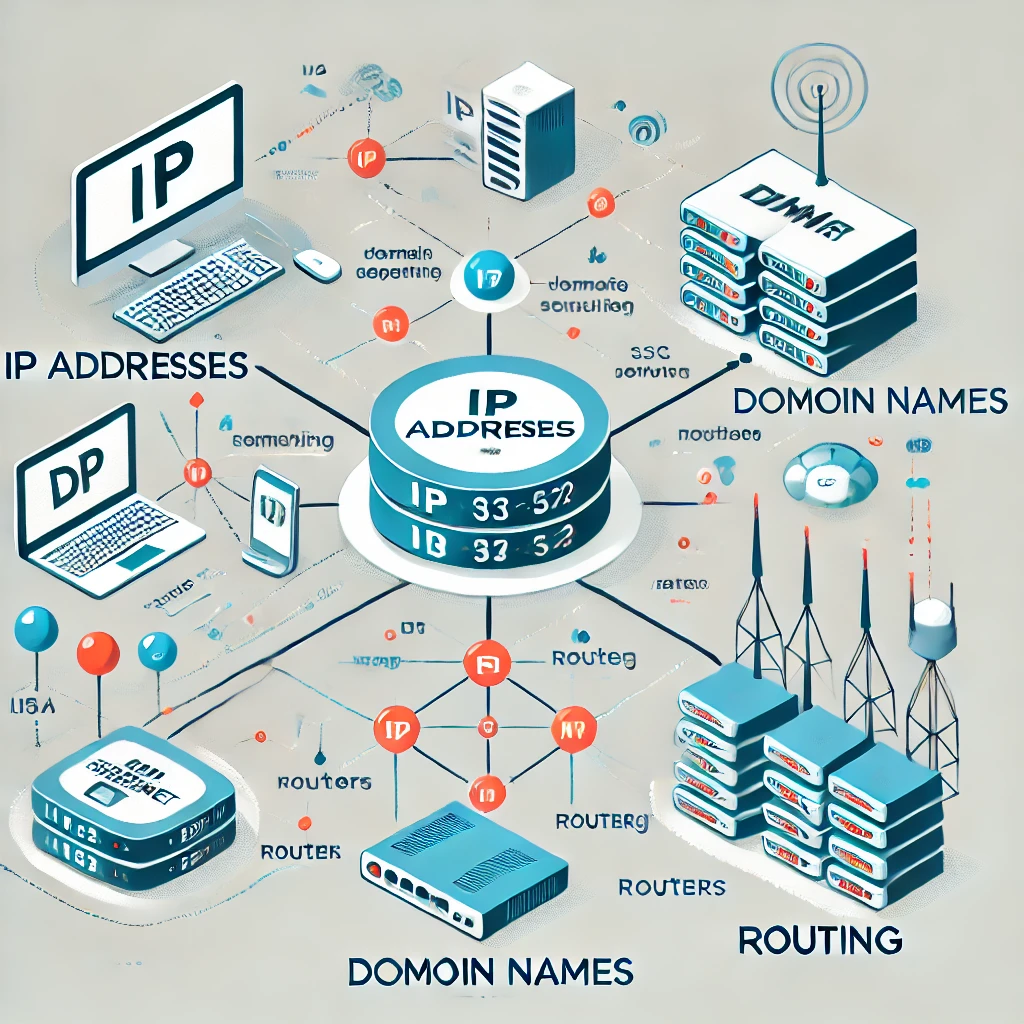The Internet: How It Works and Why It Matters
 Maulik Gajipara 🏌️
Maulik Gajipara 🏌️Table of contents
- How the Internet Works
- Why the Internet Matters
- What Are The Components of the Internet?
- What is the Basic Infrastructure of the Internet?
- How Does the Internet Work with Diagrams?
- From Browser to Server: The Journey of Data
- Breaking Down The World Wide Web A Begineer Guide
- Understanding the Backbone of the Internet: IP Address, Domain Name, and Routing

The internet is an extraordinary technological marvel that has revolutionized how we communicate, work, learn, and entertain ourselves. It’s a vast network of interconnected systems, allowing seamless data exchange across the globe. But how does it work, and why is it so significant in our lives? Let’s break it down.
How the Internet Works
At its core, the internet is a massive network of networks. It connects billions of devices—computers, smartphones, servers, and more—through wired and wireless means. Here’s a simplified journey of how it operates:
Data Requests
When you type a URL into your browser, it sends a request to a server to access specific information. This request is powered by the Hypertext Transfer Protocol (HTTP), which ensures data travels securely and efficiently.IP Addresses and Domain Names
Each device connected to the internet has a unique IP (Internet Protocol) address. When you type "www.example.com," the domain name is translated into an IP address using a Domain Name System (DNS). Think of it as a digital phonebook that helps locate the server storing your desired information.Routing and Data Transfer
The internet relies on routers to determine the best path for your data to travel. These pathways, made of fiber-optic cables, satellites, and wireless signals, ensure data reaches its destination quickly and accurately.Servers and Browsers
Once the server receives your request, it sends the required data back to your browser, displaying it as a web page. This entire process happens in mere milliseconds.
Why the Internet Matters
The internet's significance lies in its transformative impact on nearly every aspect of modern life:
Global Communication
Platforms like email, social media, and video conferencing have made it possible to stay connected with anyone, anywhere, at any time.Access to Information
The internet is an unparalleled repository of knowledge, making education, news, and research accessible to billions.Economic Growth
E-commerce, online banking, and digital startups thrive on the internet, creating jobs and driving innovation.Healthcare and Technology
Telemedicine and online health resources empower people to access medical advice and treatment remotely.Entertainment and Creativity
Streaming services, gaming, and social platforms provide endless ways to create and consume content.
What Are The Components of the Internet?
Generally, two main components uphold the functionality of the Internet, they are:
Packets
Protocols
So what are Packets and Protocols?
In networking, data transmitted through the Internet is sent via small segments/chunks, which are later translated into bits. The packets are routed to their endpoint (destination) through different networking devices, e.g., routers, or switches.
Later, once the packet arrives at the receiver’s end, small chunks of data get reassembled to utilize or check the data that he/she requested. That’s why packets are used to promote ease in networking. Large data can be easily sent by sending small units, and this whole process of sending/receiving small bits is known as Packet Switching.
An Example to Understand the Complete Concept:
Let’s say a user wants to load an image from the internet so the moment the user clicks over the image, the whole image will not open in one go. A small amount of data will start going from the server and will reach the endpoint (user) and the moment all data reaches the user’s system, the image will open on the user’s end.
Those small packets are being sent via wires, radio waves, etc. of the internet and once they complete their fetching, the user will be able to view the whole image. Theoretically, a packet may consist of 1000-1500 bytes depending upon the structure and connection.
What is the Basic Infrastructure of the Internet?
On the other end, do you know what a challenging task could be? Connecting two computers with the help of any communication method. To solve the connection issue, protocols were introduced.** It is a standardized method of performing certain tasks and data formatting so that two or more devices can communicate with each other.**
Let’s narrow it down for better clarity:
Ethernet – If both systems are connected over the same network
IP (Internet Protocol) – for receiving and sending packets from network to network
TCP (Transmission Control Protocol) – To ensure that those packets are arriving successfully in the same order,
HTTP (HyperText Transfer Protocol) – for formatting data over websites and apps
Besides this, there are several other protocols for testing, routing, and encryption, and for streaming games/videos, rather than using TCP, we use UDP (User Datagram Protocol).
The bottom line is, no matter what kind of connection you’re providing to which device, it can interpret and understand these protocols, that’s just because they’ll be connected over the Internet.
How Does the Internet Work with Diagrams?
From opening a web browser to visiting a website, it all happens with specific methods that we’re going to check in these 5 easy steps.

Firstly, you’ll be required to connect your system or PC with any router or modem to establish a connection. This connection is the base of the internet connection.
When you open the browser and start typing something like “www.google.com”, your system will push a query command to your ISP (Internet Service Provider) that is connected with other servers that store and process data.
Now, the web browser will start indexing the URL that you’ve entered and will fetch the details in numeric format (in their language to identify the address (unique) that you’re trying to reach.
Next, now your browser will start sending the HTTP request where you’re trying to reach and send a copy of the website on the user’s system. Note: The server will send data in the form of small packets (from the website to the browser)
Once all the data (of small packets) is received at the user’s end (PC/Laptop), the browser will start arranging all those small packets and later will form a collective file (here, the browser will gather all the small packets and rearrange them just like a puzzle) and then you’ll be able to see the contents of that website.
From Browser to Server: The Journey of Data

1. Making the Request
The process begins when you enter a URL (Uniform Resource Locator) into your browser’s address bar and press Enter. This action triggers your browser to send a request to access the desired webpage.
2. Translating the URL
The URL is human-friendly, but computers rely on IP (Internet Protocol) addresses to identify and locate servers. The Domain Name System (DNS) translates the URL into its corresponding IP address, much like a digital phonebook.
3. Connecting to the Server
With the IP address in hand, your browser connects to the target server using an internet protocol like TCP/IP. This establishes a connection and prepares the browser to send its request.
4. Sending the Request
Once the connection is established, the browser sends an HTTP (or HTTPS) request to the server. This request includes details like the type of content needed (HTML, images, or scripts) and information about your browser and device.
5. Processing on the Server
The server receives the request, processes it, and fetches the required data. For dynamic content, the server may interact with databases or applications to generate the necessary files.
6. Sending the Response
After processing, the server sends the requested data back to your browser. This data usually includes HTML, CSS, JavaScript files, and media like images or videos.
7. Rendering the Webpage
Your browser receives the server's response and begins rendering the webpage. It interprets the HTML structure, applies CSS for styling, and executes JavaScript for interactivity, ultimately displaying the fully functional webpage.
8. Maintaining the Connection
For modern, dynamic websites, the connection may remain active to allow real-time updates. This is achieved using protocols like WebSockets or technologies like AJAX.
Breaking Down The World Wide Web A Begineer Guide
1. What Is the World Wide Web?
The World Wide Web is a system of interlinked web pages and multimedia content that can be accessed via the internet using a web browser. It's not the internet itself but one of its most popular applications.
2. Key Components of the Web
a. Web Browsers
A web browser is software that lets you access and interact with websites. Popular examples include:
Google Chrome
Mozilla Firefox
Microsoft Edge
Safari
b. Web Pages
A web page is a document accessible through a web browser. Web pages can include:
Text
Images
Videos
Links to other pages
c. Websites
A website is a collection of related web pages hosted under a single domain name, like www.example.com.
d. Servers
Web servers store websites and make them available over the internet.
e. URLs (Uniform Resource Locators)
A URL is the address of a web page. For example:https://www.example.com/page1.html
3. How Does It Work?
Here’s a simplified explanation of how the web functions:
You Enter a URL
Type a URL in your web browser's address bar (e.g.,https://www.google.com).Your Request Is Sent
The browser sends your request to a web server using the HTTP or HTTPS protocol.The Server Responds
The server processes your request and sends back the content of the web page.The Browser Displays the Page
Your browser renders the web page using HTML, CSS, and JavaScript.
4. Important Terms to Know
a. HTML (Hypertext Markup Language)
The basic language used to create web pages.
b. CSS (Cascading Style Sheets)
Used to style web pages, including layout, colors, and fonts.
c. JavaScript
Adds interactivity to web pages, like animations or dynamic content.
d. HTTP/HTTPS
Protocols that define how messages are formatted and transmitted over the web.
HTTP: Standard protocol
HTTPS: Secure version with encryption
5. How to Start Exploring the Web
Use search engines like Google or Bing to find information.
Bookmark useful websites for quick access.
Learn basic web safety tips, such as avoiding suspicious links.
6. Tips for Beginners
Practice Searching: Refine your search terms to find specific information.
Bookmark Favorites: Save websites you visit often.
Stay Safe: Use antivirus software and only visit trusted websites.
Understanding the Backbone of the Internet: IP Address, Domain Name, and Routing

The internet is often called a "network of networks," and its backbone relies on three fundamental components: IP addresses, domain names, and routing. These elements work together to ensure data travels efficiently and accurately between devices worldwide. Let’s dive into each of them to understand their roles.
1. IP Address: The Internet’s Unique Identifier
An IP address (Internet Protocol address) is a numerical label assigned to every device connected to a network. It serves two main purposes: identifying the host and providing the location of the device on the network.
Types of IP Addresses:
IPv4: A 32-bit address format (e.g., 192.168.1.1), offering approximately 4.3 billion unique addresses.
IPv6: A 128-bit format (e.g., 2001:0db8:85a3:0000:0000:8a2e:0370:7334), introduced to accommodate the growing number of devices.
Why It Matters:
IP addresses allow devices to locate and communicate with each other, acting as the internet’s navigation system.
2. Domain Name: The Human-Friendly Address
While IP addresses are essential, they are difficult for humans to remember. This is where domain names come into play.
What is a Domain Name?
A domain name is a user-friendly representation of an IP address. For example, "www.example.com" points to a specific IP address, making it easier for users to access websites.How It Works:
When you type a domain name into your browser, the Domain Name System (DNS) translates it into the corresponding IP address, enabling your device to connect to the target server.Why It Matters:
Domain names simplify internet navigation, making it accessible and intuitive for users worldwide.
3. Routing: Directing Data Traffic
Routing is the process of selecting the best path for data to travel from its source to its destination across the internet.
How Routing Works:
Data is divided into small packets before being sent.
Routers examine the destination IP address of each packet and determine the optimal path to send it.
Packets may take different routes and are reassembled at the destination.
Routing Protocols:
Protocols like BGP (Border Gateway Protocol) and OSPF (Open Shortest Path First) enable routers to communicate and make routing decisions.Why It Matters:
Routing ensures data travels efficiently and reliably, even across vast and complex networks.
The Backbone in Action
When you search for something online or stream a video, these three components—IP addresses, domain names, and routing—work seamlessly together:
Your browser sends a request to a server using the domain name.
The DNS translates the domain name into an IP address.
Routers direct the data packets along the best path to the server and back to your device.
Subscribe to my newsletter
Read articles from Maulik Gajipara 🏌️ directly inside your inbox. Subscribe to the newsletter, and don't miss out.
Written by
